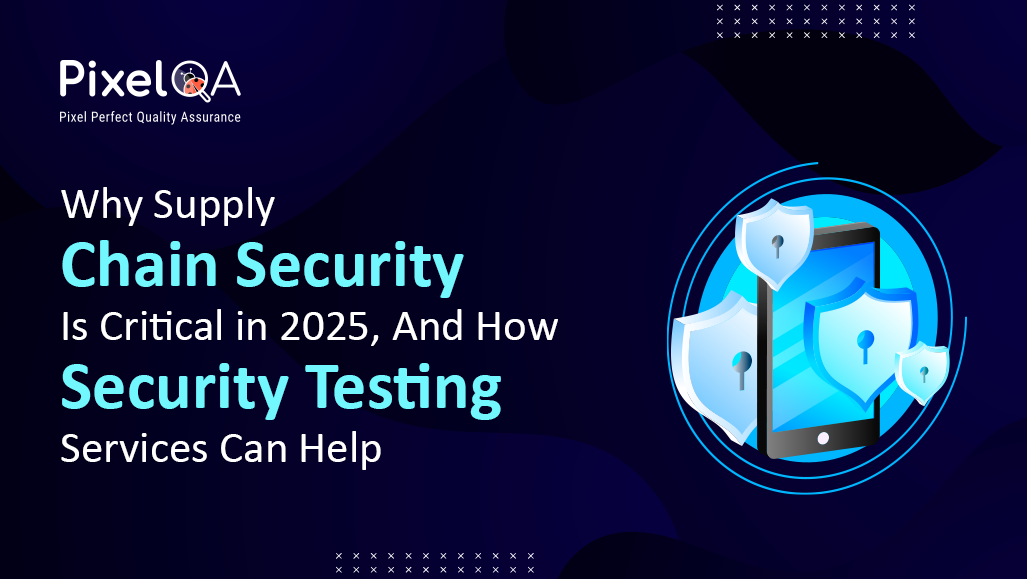
In today’s digital‑first world, every business, large or small, depends on a network of suppliers, partners, vendors, and service providers. This web of interconnections—called the supply chain—is the backbone of how modern organizations function. But just as it brings efficiency, it also brings serious cybersecurity risks.
When it comes to hacking, supply chain security is one of the most discussed topics in the US and globally. Major cyberattacks in recent years have occurred when hackers discovered flaws in a supplier or third‑party vendor rather than directly targeting a corporation—an easier and often more effective method for attackers.
In this blog post, we explore what supply chain security is, why it’s more important than ever in 2025, how attackers exploit it, and how organizations can use security testing services to protect themselves.
What Is Supply Chain Security?
In the online world, supply chain security refers to safeguarding the entire network of outside suppliers and service providers that a business relies on. This covers cloud service providers, hardware producers, software suppliers, logistics partners, and more.
If any third party in your supply chain lacks proper cybersecurity, your business can be compromised. Hackers who break into a vendor’s system may gain access to your data, internal apps, or networks.
For example, imagine using a software tool from a third‑party vendor. If that vendor is hacked, attackers could push malware into your company through legitimate software updates or integrations—without you even knowing.
Why Is Supply Chain Security a Major Concern in 2025?
Supply chain security is now a top priority for cybersecurity professionals and business leaders for several reasons:
- Growing Number of Vendors
Most companies today use dozens, if not hundreds, of third‑party tools and services. Each one can introduce new vulnerabilities if not properly secured. - More Sophisticated Hackers
Attackers are smarter and better equipped. They know smaller vendors are often easier targets than big corporations with advanced security defenses. - Remote Work & Cloud Technology
Remote work and cloud solutions create more pathways to sensitive data. Hackers exploit third‑party connections to slip in. - High‑Profile Attacks
Recent attacks such as SolarWinds, Kaseya, and MOVEit show that supply‑chain breaches can ripple across hundreds of organizations at once.
Examples of Supply Chain Attacks in the Real World
- SolarWinds Attack (2020): Hackers added malicious code to SolarWinds software updates, which were installed by 18,000+ customers—including major U.S. government departments and Fortune 500 companies.
- Kaseya VSA Ransomware Attack (2021): Vulnerabilities in a managed service provider’s platform let ransomware spread to hundreds of small and midsize businesses within hours.
- MOVEit File Transfer Breach (2023): A popular file‑sharing tool used by banks, insurers, and health providers was compromised, leaking sensitive customer and business data.
Explain Security Testing Services
To lower supply‑chain risks, more companies now turn to security testing services. Cyber‑specialists perform a range of tests and assessments to pinpoint weaknesses before criminals do.
Common types include:
- Penetration Testing: Simulates an attack to uncover and remediate vulnerabilities.
- Vulnerability Assessment: Scans for known security flaws.
- Source Code Review: Examines code for logical errors or hidden defects.
- Third‑Party Risk Assessment: Evaluates vendor security posture.
- Configuration Audit: Confirms systems and software are configured securely.
These services not only strengthen your own defenses; they also verify that your suppliers meet your cybersecurity requirements.
How Security Testing Services Protect Supply Chains
- Vendor Evaluation: Review a vendor’s architecture, data policies, and systems before partnering to ensure they don’t add risk.
- Ongoing Monitoring: Regular assessments scan for new vulnerabilities as partners update their systems.
- Security Validation: Pen‑testing or red‑teaming simulates real attacks to confirm vendors’ defenses.
- Compliance & Auditing: Testing services help satisfy frameworks such as CMMC, GDPR, and HIPAA.
- Incident Preparedness: Pre‑tested systems let teams respond faster; some firms also craft supply‑chain‑specific incident response plans.
How to Make Your Company’s Supply Chain More Secure
- ✅ Create a Vendor Inventory: Keep an up‑to‑date list of all vendors and tools; note which access sensitive data.
- ✅ Set Security Requirements: Include cybersecurity clauses in vendor contracts; require testing or audit proof.
- ✅ Limit Access: Grant vendors only the minimum permissions they need (principle of least privilege).
- ✅ Use Zero Trust Architecture: Assume nothing is secure—even inside your network. Authenticate and authorize everything.
- ✅ Regular Security Testing: Test both internal teams and vendors to keep defenses current.
- ✅ Train Your Employees: Teach staff to spot phishing, social engineering, and suspicious vendor activity.
The Future of Supply Chain Security
As technology evolves, so do supply‑chain threats. Expect to see:
- AI‑Powered Threat Detection that spots anomalies in real time.
- Blockchain for secure, immutable tracking of updates and vendor activity.
- Stronger regulations (e.g., U.S. Cybersecurity Executive Order) mandating supply‑chain security.
- Wider adoption of security testing services—now recognized as essential, not optional.
Conclusion
By 2025, supply chain security is integral to enterprise defense. With ever‑growing numbers of vendors, tools, and integrations, you can’t assume everyone in your ecosystem is secure.
To stay ahead, be proactive: test, verify, and collaborate with trusted partners. Your system’s security is only as strong as its weakest link—so strengthen every link with knowledge, rigorous testing, and continuous vigilance.
About Author

Rushi Mistry is a Security Analyst at PixelQA with a focus on cybersecurity. He is passionate about IoT penetration testing and is working towards obtaining a CISSP certification, with the ultimate goal of becoming a Chief Information Security Officer (CISO).

